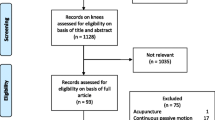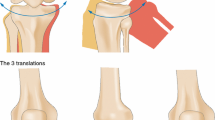Abstract
Purpose
The aim of this study was to identify the minimal clinically important difference (MCID) in the Oxford knee score (OKS) and Short Form (SF-) 12 score after total knee arthroplasty (TKA).
Methods
Prospective pre-operative and 1 year post-operative OKS and SF-12 scores for 505 patients undergoing a primary TKA for osteoarthritis were collected during a one-year period. Patient satisfaction with their (1) patient relief and (2) functional outcome was used as the anchor questions. Their response to each question was recorded using a 5-point Likert scale: excellent, very well, well, fair, and poor. Simple linear regression was used to calculate the MCID for improvement in the OKS and physical component of the SF-12 score according to the level of patient satisfaction with their pain relief and function.
Results
The OKS improved by 15.5 (95 % CI 14.7–16.4) points and the SF-12 physical component score improved by 10.1 (95 % CI 9.1–11.2) points for the study cohort. The level of patient satisfaction with their pain relief and function correlated with the improvement in the OKS (r = 0.56; p < 0.001, and r = 0.56; p < 0.001) and the physical component of the SF-12 score (r = 0.51; p < 0.001, and r = 0.60; p < 0.001), respectively. The MCID for the OKS was 5.0 (95 % CI 4.4–5.5) and 4.3 (95 % CI 3.8–4.8) points and for the physical component of the SF-12, it was 4.5 (95 % CI 3.9–5.2) and 4.8 (95 % CI 4.2–5.4) points for pain relief and function, respectively.
Conclusion
The MCID identified for the OKS and SF-12 physical component score after TKA is the best available estimate and can be used to power studies and ensure that a statistical difference is also recognised by a patient.
Level of evidence
Retrospective diagnostic study, Level III.


Similar content being viewed by others
References
Andrew G, Beard D, Nolan J, Murray DW, Tuson K (2006) Which approach for total hip replacement? Hip Int 16:118–119
Baker PN, van der Meulen JH, Lewsey J, Gregg PJ (2007) The role of pain and function in determining patient satisfaction after total knee replacement. Data from the National Joint Registry for England and Wales. J Bone Joint Surg Br 89:893–900
Baker PN, Deehan DJ, Lees D, Jameson S, Avery PJ, Gregg PJ, Reed MR (2012) The effect of surgical factors on early patient-reported outcome measures (PROMS) following total knee replacement. J Bone Joint Surg Br 94:1058–1066
Bellamy N, Buchanan WW, Goldsmith CH, Campbell J, Stitt LW (1988) Validation study of WOMAC: a health status instrument for measuring clinically important patient relevant outcomes to antirheumatic drug therapy in patients with osteoarthritis of the hip or knee. J Rheumatol 15:1833–1840
Bombardier C, Melfi CA, Paul J, Green R, Hawker G, Wright J, Coyte P (1995) Comparison of a generic and a disease-specific measure of pain and physical function after knee replacement surgery. Med Care 33:AS131–AS144
Brander V, Gondek S, Martin E, Stulberg SD (2007) Pain and depression influence outcome 5 years after knee replacement surgery. Clin Orthop Relat Res 464:21–26
Clement ND, Burnett R (2013) Patient satisfaction after total knee arthroplasty is affected by their general physical well-being. Knee Surg Sports Traumatol Arthrosc. doi:10.1007/s00167-013-2523-y
Clement ND, MacDonald D, Howie CR, Biant LC (2011) The outcome of primary total hip and knee arthroplasty in patients aged 80 years or more. J Bone Joint Surg Br 93:1265–1270
Clement ND, Jenkins PJ, Macdonald D, Nie YX, Patton JT, Breusch SJ, Howie CR, Biant LC (2013) Socioeconomic status affects the Oxford knee score and short-form 12 score following total knee replacement. Bone Jt J 95-B:52–58
Clement ND, Macdonald D, Burnett R (2013) Predicting patient satisfaction using the Oxford knee score: where do we draw the line? Arch Orthop Trauma Surg 133:689–694
Clement ND, Macdonald D, Burnett R (2013) Primary total knee replacement in patients with mental disability improves their mental health and knee function: a prospective study. Bone Jt J 95-B:360–366
Collins NJ, Roos EM (2012) Patient-reported outcomes for total hip and knee arthroplasty: commonly used instruments and attributes of a “good” measure. Clin Geriatr Med 28:367–394
Dawson J, Fitzpatrick R, Murray D, Carr A (1998) Questionnaire on the perceptions of patients about total knee replacement. J Bone Joint Surg Br 80:63–69
Department for health (2010) Equity and excellence: liberating the NHS http://www.dh.gov.uk/en/Publlicationsandstatistics/Publications/PubicationsPolicyAndGuidance/DH_117353
Escobar A, Quintana JM, Bilbao A, Arostegui I, Lafuente I, Vidaurreta I (2007) Responsiveness and clinically important differences for the WOMAC and SF-36 after total knee replacement. Osteoarthritis Cartilage 15:273–280
General Register Office for Scotland (2008) http://www.gro-scotland.gov.uk/files2/stats/gros-mid-2008-population-estimates-scotland-population-estimates-by-sex-age-and-administrative-area/j1075008.htm
Guyatt GH, Feeny DH, Patrick DL (1993) Measuring health-related quality of life. Ann Intern Med 118:622–629
Insall JN, Dorr LD, Scott RD, Scott WN (1989) Rationale of the Knee Society clinical rating system. Clin Orthop Relat Res 248:13–14
Jaeschke R, Singer J, Guyatt GH (1989) Measurement of health status. Ascertaining the minimal clinically important difference. Control Clin Trials 10:407–415
Keurentjes JC, Van Tol FR, Fiocco M, Schoones JW, Nelissen RG (2012) Minimal clinically important differences in health-related quality of life after total hip or knee replacement: a systematic review. Bone Jt Res 1:71–77
King MT (2011) A point of minimal important difference (MID): a critique of terminology and methods. Expert Rev Pharmacoecon Outcomes Res 11:171–184
Murray DW, Fitzpatrick R, Rogers K, Pandit H, Beard DJ, Carr AJ, Dawson J (2007) The use of the Oxford hip and knee scores. J Bone Joint Surg Br 89:1010–1014
Parker SL, Mendenhall SK, Shau DN, Adogwa O, Anderson WN, Devin CJ, McGirt MJ (2012) Minimum clinically important difference in pain, disability, and quality of life after neural decompression and fusion for same-level recurrent lumbar stenosis: understanding clinical versus statistical significance. J Neurosurg Spine 16:471–478
Parker SL, Godil SS, Shau DN, Mendenhall SK, McGirt MJ (2013) Assessment of the minimum clinically important difference in pain, disability, and quality of life after anterior cervical discectomy and fusion: clinical article. J Neurosurg Spine 18:154–160
Revicki D, Hays RD, Cella D, Sloan J (2008) Recommended methods for determining responsiveness and minimally important differences for patient-reported outcomes. J Clin Epidemiol 61:102–109
Robertsson O, Dunbar M, Pehrsson T, Knutson K, Lidgren L (2000) Patient satisfaction after knee arthroplasty: a report on 27,372 knees operated on between 1981 and 1995 in Sweden. Acta Orthop Scand 71:262–267
Roos EM, Roos HP, Ekdahl C, Lohmander LS (1998) Knee injury and Osteoarthritis Outcome Score (KOOS)—validation of a Swedish version. Scand J Med Sci Sports 8:439–448
Scott CE, Howie CR, MacDonald D, Biant LC (2010) Predicting dissatisfaction following total knee replacement: a prospective study of 1217 patients. J Bone Joint Surg Br 92:1253–1258
Scott CE, Bugler KE, Clement ND, Macdonald D, Howie CR, Biant LC (2012) Patient expectations of arthroplasty of the hip and knee. J Bone Joint Surg Br 94:974–981
Walther BA, Moore JL (2005) The concepts of bias, precision and accuracy, and their use in testing the performance of species richness estimations, with a literature review of estimator performance. Ecography 28:815–829
Ware JE Jr, Sherbourne CD (1992) The MOS 36-item short-form health survey (SF-36). I. Conceptual framework and item selection. Med Care 30:473–483
Ware JE Jr, Kosinski M, Bayliss MS, McHorney CA, Rogers WH, Raczek A (1995) Comparison of methods for the scoring and statistical analysis of SF-36 health profile and summary measures: summary of results from the Medical Outcomes Study. Med Care 33:AS264–AS279
Ware J, Kosinski M, Keller SD (1996) A 12-Item Short-Form Health Survey: construction of scales and preliminary tests of reliability and validity. Med Care 34:220–233
Conflict of interest
The authors declare no conflict of interest with the content of this study.
Author information
Authors and Affiliations
Corresponding author
Rights and permissions
About this article
Cite this article
Clement, N.D., MacDonald, D. & Simpson, A.H.R.W. The minimal clinically important difference in the Oxford knee score and Short Form 12 score after total knee arthroplasty. Knee Surg Sports Traumatol Arthrosc 22, 1933–1939 (2014). https://doi.org/10.1007/s00167-013-2776-5
Received:
Accepted:
Published:
Issue Date:
DOI: https://doi.org/10.1007/s00167-013-2776-5




